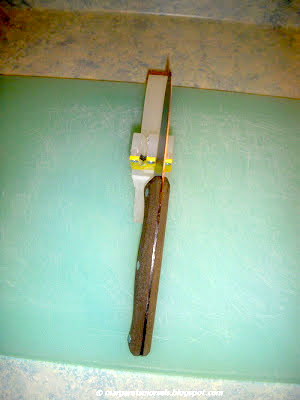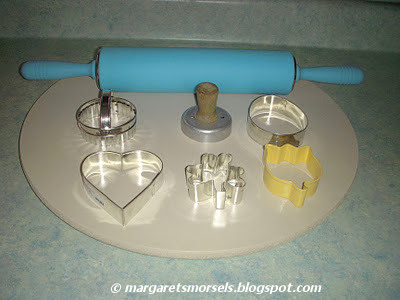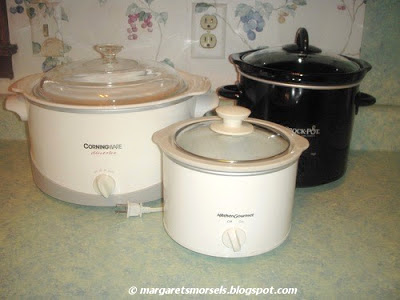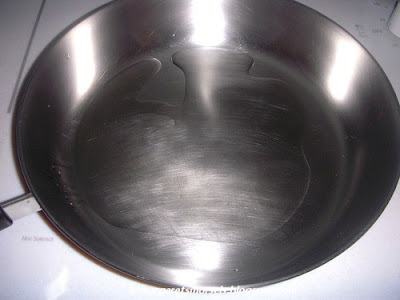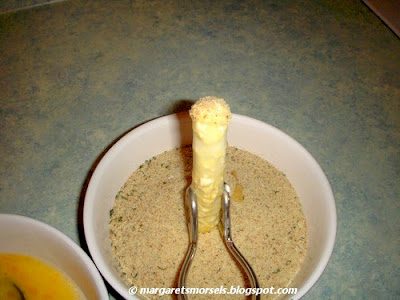Cooking can be a lot of fun -- and produce tasty results -- but it's also a lot of work. Like any chore, cooking is easier when you have the right tools.
A friend that's getting married asked me what kitchen items she should include on her bridal registry. She's a novice cook and is overwhelmed by the vast array of merchandise to choose from in the store. I emailed her a list of suggestions and thought others might find it useful too.
Whether you're purchasing things for your first home, looking for tools to make cooking easier or new ways to use tools you already own, I thought I'd share my list of kitchen must haves with links to recipes that use those items. This list only includes tools used to prep food. It isn't all inclusive, but these are the tools I rely on when I'm cooking for three or twenty three.
Dry Measuring Cups: These cups are designed for dry ingredients such as flour, sugar and shortening. The blue set is a standard set with sizes ranging from 1/4 to 1 cup. The orange set includes the standard cups plus 2/3 and 3/4 cup. The metal cup is a 1/8 cup that comes in handy when I need 2 tablespoons of an ingredient.
Liquid Measuring Cups: These cups are designed for wet ingredients. They range in size from 1 to 8 cups and have a pour spout. They're also useful for melting butter, margarine or shortening in the microwave. I have these in 1, 2 and 4 cup sizes.
Temperature's Rising:
Digital Thermometer: This is one of my favorite kitchen finds in a long time. Unlike instant read thermometers, this thermometer can be programmed to beep when the food reaches the desired temperature. I always use it when I cook Marinated Pork Tenderloin.
Paring Knife: I use this to peel apples, cut tomatoes, slice cheese and for other jobs that don't require a big knife.
Kitchen Shears: Unlike regular scissors, kitchen shears have one serrated blade and one regular blade. They make easy work of jobs that would be difficult to do with a knife. Use shears to cut dried herbs, dried beef, uncooked bacon and canned whole tomatoes into small pieces. Spraying the shears with nonstick cooking spray makes chopping dried fruit a breeze.
Santoku Knife: I bought this several years ago and I absolutely love it! It's shorter than a chef's knife and has a straighter blade which doesn't allow for a "rocking" motion like a chef's knife. The grooves on the blade prevent food from sticking when being cut.
Bread Knife: This knife has a serrated edge which makes it ideal for slicing a loaf of bread without tearing it up. If you can find a loaf of unsliced cinnamon bread, use this knife to slice it for French Toast Souffle.
Knife Sharpener: Over time, knives lose their edge. Unless you want to pay a professional, you'll need a way to sharpen knives at home. There are sharpening steels and stones, but I'm not comfortable using them since the knives have to be held at a certain angle. I use a handheld sharpener that eliminates the need to hold the knives at the correct angle.
Cutting Board: I prefer plastic over wood since plastic can be washed in the dishwasher. I avoid glass because they can chip plus the surface is hard on the edge of a knife.
Ice Cream Scoop: My vegetable peeler may be old school, but my ice cream scoop is modern. The scoop has a nontoxic fluid in the handle that is heated by your hand. This heating process makes scooping ice cream effortless.
Cookie Scoops: These aren't just for cookies! I have three -- small, medium and large -- and also use them for cake batter, sausage balls and chicken salad.
Bottle Opener/Can Opener: Even though more and more cans have pull tops, it's still a good idea to keep these around, especially the manual kind.
Pizza Wheel: This isn't just for cutting pizza. Use it to make lattice strips for pies, cut bar cookies and cut bread dough.
Pastry Brush: Useful for basting food as well as brushing a glaze or melted butter over the surface of food.
Juicer: A quick and easy way to squeeze juice from lemons or limes. There's a larger version for oranges.
Apple Wedger: This handy device cores and wedges an apple at the same time. It's much faster than using a knife.
Meat Pounder: Great for tenderizing meat and making the pieces uniform size.
Pastry Blender: A quick way to incorporate fat into dry ingredients. It makes the job easier than using two knives to do the same thing.
Turner: This is ideal for turning pancakes, but you can also use it to turn French toast, grilled cheese sandwiches and remove cookies from a baking sheet to a cooling rack.
Turner: This is ideal for turning pancakes, but you can also use it to turn French toast, grilled cheese sandwiches and remove cookies from a baking sheet to a cooling rack.
Wooden Spoon: I don't like metal spoons, but I don't always want plastic either. Wood is a good alternative.
Pasta Fork: I use this to stir pasta while it's cooking. You can also use it to transfer pasta from a serving platter to a plate.
Ladle: Use a large ladle for big jobs -- soup or chili -- and a small ladle for small jobs like queso dip.
Slotted Spoon/Spoon: Use the slotted spoon to retrieve food from a liquid. Use the regular spoon for stirring.
Just Grate:
Microplane Zester: This tool makes zesting citrus easy. It's also good for grating cheese and nutmeg. It grates things more finely than a handheld grater.
What's Shaking:
Strainer: Also called sieves, these come in a variety of shapes, sizes and mesh densities. I use them to sift dry ingredients, but they're also good for draining ingredients for dishes such as potato salad.
Colander: Good for draining pasta and potatoes, rinsing lettuce and washing grapes. It's nice to have different sizes for large or small jobs.
Whisk: An easy way to blend ingredients. Use a large whisk to combine dry ingredients and a small whisk to beat eggs.
Mixing Bowls: A graduated set will give you the right size bowl for most any job. If the bowls have lids, you can mix and store in the same bowl.
Dough Board: This is a must if you make rolls, cookies or anything that needs to be rolled out.
Rolling Pin: I never was a fan of rolling out dough until I bought a silicone rolling pin. I find the dough is easier to roll out and less likely to stick than with a wooden rolling pin.
Cookie Cutters: If you make cutout cookies, you'll need a way to cut them into shapes. I think metal cookie cutters make sharper impressions and are easier to use than plastic cookie cutters.
Electric Hand Mixer: Although I have a stand mixer, I only use it when I do heavy duty baking. I use my hand mixer for everything else. If you ever have to replace your mixer, save the beaters and see if they'll work in the new mixer. A second pair of beaters comes in handy.
Blender: A couple of years ago, a friend gave me a Ninja Master Prep which is similar to a blender. At the time, I didn't know how much I'd use it, but I use it a lot. I've used it to make bread crumbs and chop vegetables for cornbread dressing, blend omelet ingredients and puree soup.
Salad Spinner: I always thought this was a useless kitchen gadget until I actually used one. Nothing dries greens faster or better than a salad spinner. Even if you buy prepackaged, prewashed salad mix, it's still a good idea to wash it. My salad spinner is over 20 years old and has a crank on top that you turn which spins the inner basket. Some newer models have a cord you pull to make the basket spin.
Bacon Wave: This is a must have only if you cook bacon frequently. The easiest and, in my opinion, tastiest way to cook bacon is in the microwave. This handy gadget allows the grease to drain away from the bacon as it cooks. I use this not only when I cook bacon for breakfast, but whenever cooked bacon is called for in a recipe.
Since the list of prep tools is pretty extensive, I'll make this a two part blog. Check back later this week for my kitchen must haves for cooking and baking.
© Margaret's Morsels





